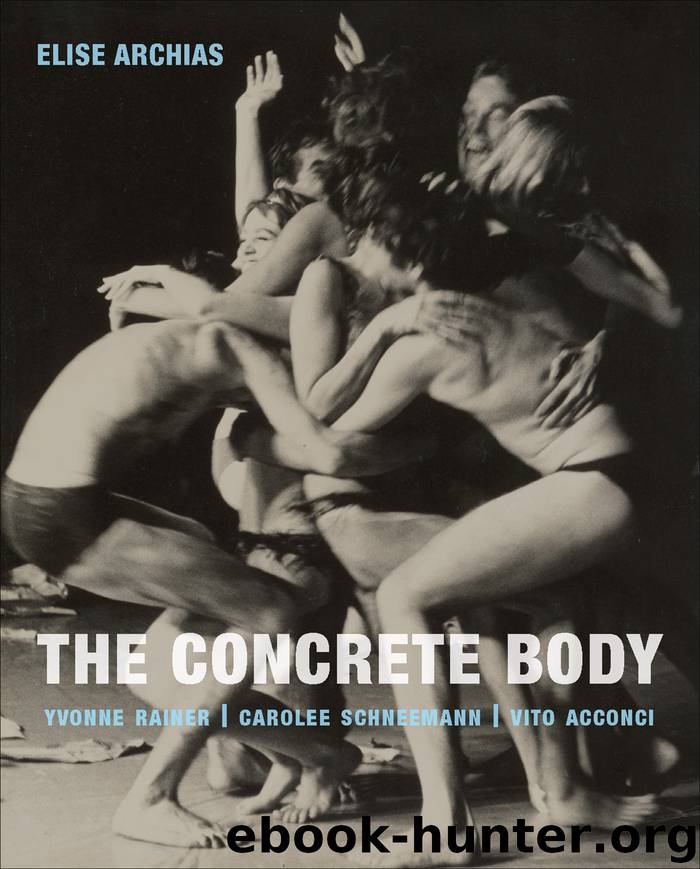The Concrete Body by Elise Archias

Author:Elise Archias
Language: eng
Format: epub
Publisher: Yale University Press
Published: 2016-03-13T16:00:00+00:00
FIGURE 81
Carl Andre, back cover, Interfunktionen, November 1970. 12 × 83/4 in. (30.5 × 22.2 cm). Image courtesy of Acconci Studio.
The broad emphasis on structure in an art world informed by conceptual art ensured that abstract ideas were given priority over sensuous pleasure, making clear the artist’s critical awareness of art’s complicity with the current spectacular hegemonic culture. In an article on the new category of “body art” that included Acconci’s work, for example, the critic Cindy Nemser readily volunteered her understanding that “the body artists … are attempting to give us a message about the frightening and dangerous aspects of our society.”20 The systems addressed by this broadly sweeping critical understanding in 1970 were understood to oppress on levels less conscious than the level of public struggle over rights that had been the emphasis during the previous decade of protest and social movements. “There are structures that limit things,” Acconci said in an interview with Nemser in 1971. “An art work might be a means to see and examine possibilities that these structures have eliminated.”21 Like many in the feminist and black power movements attempting to make “personal” forces of oppression “political” and thus public, Acconci subscribed to “the idea of social structure setting up categories of privacies. A lot of my work is involved in getting rid of these privacies…. People don’t have to be limited by roles, they don’t have to be rigidly enclosed in categories.”22 The new sense of overbearing rules, of governing structure per se, was as deeply rooted in the very fibers of one’s body as it was imposed by the family unit, urban planning, the museum, or any of the other entities that Althusser had called “ideological state apparatuses,” and it sent artists and activists alike searching for new ways to address wider social problems.23
Acconci’s efforts are quite different from many less embodied examples of conceptual art, however. A great deal of conceptual art did its best to appear as all structure, embracing language, maps, and statistical notation, while shunning subtle variations in texture, density and volume. Joseph Kosuth’s One and Three Chairs (1965), for example, an installation exhibited alongside Acconci’s 3 Adaptation Studies and Service Area in July 1970 in the Information show at MoMA, makes its cool, philosophical proposition—Word is not equal to Photograph is not equal to Object—in a manner that is incontrovertibly true, but because the proposal is structured around such minimal content, the differences between the three “chairs” hardly matter, mutely negating each other rather than expanding the artwork’s vocabulary into multiple registers (fig. 82). Mel Bochner put forward a similar dismantling of the givenness and authority of language by presenting it as only one sign system among many in Language Is Not Transparent (1970), shown in Language IV at the Dwan Gallery with Acconci’s Specification Piece (fig. 83). Scrawled in chalk directly on the wall at chest level over a painted black rectangle that has been allowed to drip messily past its bottom edge toward the floor,
Download
This site does not store any files on its server. We only index and link to content provided by other sites. Please contact the content providers to delete copyright contents if any and email us, we'll remove relevant links or contents immediately.
| Body Art & Tattoo | Calligraphy |
| Ceramics | Conceptual |
| Digital | Erotic |
| Film & Video | Glass |
| Graffiti & Street Art | Illuminations |
| Installations | Mixed Media |
| Mosaic | Prints |
| Public Art | Video Games |
Kathy Andrews Collection by Kathy Andrews(11728)
Thirteen Reasons Why by Jay Asher(8792)
The Red Files by Lee Winter(3367)
How to Do Nothing by Jenny Odell(3232)
The Genius of Japanese Carpentry by Azby Brown(3224)
Stacked Decks by The Rotenberg Collection(2811)
Tattoo Art by Doralba Picerno(2600)
Champions of Illusion by Susana Martinez-Conde & Stephen Macknik(2414)
The Artist's Way Workbook by Cameron Julia(2196)
The Art of Doom by Bethesda(2106)
Calligraphy For Dummies by Jim Bennett(1992)
Creative Character Design by Bryan Tillman(1888)
Botanical Line Drawing by Peggy Dean(1812)
Wall and Piece by Banksy(1781)
The Art of Creative Watercolor by Danielle Donaldson(1777)
One Drawing A Day by Veronica Lawlor(1767)
Art Of Atari by Tim Lapetino(1750)
Pillars of Eternity Guidebook by Obsidian Entertainment(1624)
Happy Hand Lettering by Jen Wagner(1558)
